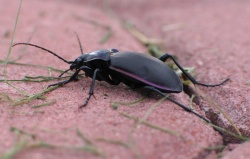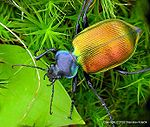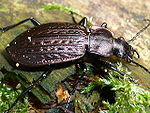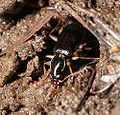| Ground beetle |
 |
| Scientific Classification |
|
|
| Subfamilies |
- Apotominae
- Brachininae
- Broscinae
- Carabinae
- Cicindelinae
- Cicindinae
- †Conjunctiinae
- Elaphrinae
- Gehringiinae
- Harpalinae
- Hiletinae
- Loricerinae
- Melaeninae
- Migadopinae
- Nebriinae
- Nototylinae
- Omophroninae
- Patrobinae
- Paussinae
- †Protorabinae
- Psydrinae
- Scaritinae
- Siagoninae
- Trechinae [1]
|
Ground beetles are any of the species of beetles belonging to the taxonomic family Carabidae. It is one of the most successful families in Coleoptera with over forty thousand species, and are found in nearly all areas of the world. You can initially spot them by their hard outer shells, called exoskeletons, and usually a pair of antennae and wing covers are present. Carabids can be as small as a millimeter or even up to four centimeters. Some of the bigger-sized species belonging to the Carabidae family can live from two to four years. They are predominately nocturnal and prefer to hide under rocks or near the roots of plants during the day. Most carabids have wings, but some have to much bulk to be supported by their flimsy wings and must resort to walking. Most Carabids are carnivorous and love to eat mainly any insect smaller than them. Some of their common prey include: earthworms, caterpillars, larvae and pupae of many different types of insect species.[2]
Body Design

A brightly shimmering
Calosoma sycophanta, otherwise commonly known as a forest caterpillar hunter, perched atop a leaf.
The Carabid family is an incredibly diverse group of insects. They are considered medium sized; forty-three to forty-six percent of all species are 4.1–8.0 mm, and twenty-eight to thirty-one percent are 8.1–16.0 mm [3]. Carabids come in many different colors, from a jet black to a camouflage brown, some a brilliant green likened to that of a sparkling jade. They all contain a flat exoskeleton, are macropterous (meaning they have large wings) [4] , and wing covers (called an elytra) that encase the whole abdomen.The head has antennae segmented into eleven parts and fearsome mandibles that proudly extend outward. The section behind the head (called the prothorax) is a bit larger in width than the head. Like all other insects, the carabid's body is divided into three sections: the head, thorax, and the abdomen. The exoskeleton is composed of plate-like structures called sclerites, which are each abstracted by thin sutures. Carabid larvae have limbs with six segments, and often have two claws attached to each limb. [5] They exhibit wing dimorphism- meaning that there are two distinct types of wings within one species of the family Carabidae. [6]
Carabid larvae are mainly predators, but a few are herbivores (meaning "feeding on plants")[7] or parasitoids ("the feeding by certain insect larvae on host tissues such that the host remains alive until larval development is complete and then usually dies").[8]They eat by using a process found in many animals and insects called external digestion. External digestion occurs when the Carabid spits up acidic digestive juices from its stomach onto its prey.[9]The juices start to dissolve the prey's form into fluid, so that the Carabid is able to suck up and eat it. This is a remarkably effective technique. [10]
Life Cycle
Along with every other type of beetle, Carabids experience a process called complete metamorphosis. Complete metamorphosis contains four stages: egg, larvae, pupa, and the adult stage. The process of metamorphosing through each stage is complete within one year for most ground beetle species. A Carabid's life starts within the form of an egg, laid by a mature adult of the same species. The egg is either buried in the ground with great care and covered with soil, or placed on top of the ground. Customarily, within one week the egg hatches and a brand new larva emerges. The larva then must quickly learn to fend for itself.
Before the larvae is able to pupate, it must go through stages called instars (A stage between molts in an insect's life).[11] Larvae typically go through two to four instars before the move on to the pupa form. Once it is complete with growing, the larvae digs into the earth and constitutes a pupal chamber (while the Carabid is in it's pupal stage it is mainly sessile and not able to defend itself, so having a pupal chamber underground is a safe option). The larvae abides within the chamber for only about five to ten days to pupate fully (a process controlled by hormones). While the Carabid is in its pupal chamber, it develops the adult characteristics and rids itself of the larvae characteristics. Once the Carabid emerges from the pupal form, it is officially finished with complete metamorphosis and is now ready to reproduce. Carabids that breed during the spring are in their larval stage during the winter, and carabids that use winter for their breeding time spend spring as larvae.
Ecology
Eating Habits

A Carabus Granulatus otherwise known as a Granulated Carabid, maneuvering around the bark and foliage of the forest floor.
Carabids are predominately carnivorous. They are very helpful to humans, for they are able to eradicate pesky insects and have a never ending desire to eat (the more technical term is "polyphagous"). [12] Carabids are foragers: they hunt for anything they can digest, including live prey, the rotting remains of former live prey (called carrion), and plant material.
Bioindicators
Carabids are able to promptly respond to environmental changes, which allows them to be fantastic bioindicators. Their bodies and behavior are able to greatly change due to biotic (relating to living organisms) [13] and abiotic (light, temperature, atmospheric gases) differences. [14] Humans can use the indicative behavior of carabids to discover more about the surrounding species, pollution, natural and human-caused disturbances, environmental changes, and the presence or absence of certain species. This is very helpful to scientists and environmental managers, for carabids can offer special insight into the enviroment.[3]
Defense Mechanisms
- Main Article: Bombardier beetle
Since the Carabid family contains such a diverse group of insects, it is not surprising that Carabids contain such interesting defense mechanisms. Carabids belonging to the Adephaga suborder, contain two glands called "Pygidial Glands" on its lower abdomen that can produce toxic liquids to defend itself from predators. The Anthini carabid can squirt their toxic secretions for long distances with incredible accuracy. The common bombardier beetle can produce something like a small explosion (actually acrid gas) that can sting a human or even kill a smaller invertebrate. [15]
Gallery
-
Caterpillar Searcher
(C. Sycophanta)
Genus: Calosoma
-
Snail-Eating Ground Beetle
(C. Caraboides)
Genus: Cychrus
-
No common name
(A. Albipes)
Genus: Agonum
-
Violet Ground Beetle
(C. Violaceus)
Genus: Carabus
References
- ↑ Carabidae. Wikispecies. Web. Last modified August 3, 2011. Author unknown.
- ↑ Ground Beetles, Family Carabidae. Ground Beetles, Family Carabidae. Web. Date Accessed: 21 November 2011
- ↑ 3.0 3.1 Forty years of carabid beetle research in Europe – from taxonomy, biology, ecology and population studies to bioindication, habitat assessment and conservation. pensoft. Web. Kotze, Johan. Date Accessed: 20 May 2011
- ↑ Macropterous. The Free Dictionary. Web. Merriam, Webster. Date Accessed: 15 November 2011
- ↑ Family Carabidae - Ground Beetles. Bugguide. Web. Bartlett, Troy. Date Accessed: 21 November 2011
- ↑ Dimorphism. The Free Dictionary. Web. Merriam, Webster. Date Accessed: 15 November 2011
- ↑ Herbivores. Dictionary Reference. Web. Merriam, Webster. Date Accessed: 21 November 2011
- ↑ Parasitoids. Dictionary Reference. Web. Merriam, Webster. Date Accessed: 21 November 2011
- ↑ Family Carabidae-Ground Beetles. Bug Guide. Web. Bartlett, Troy. Date Accessed: 21 November 2011
- ↑ Ground Beetles:-Carabidae. Earthlife. Web. Ramel, Gordon. Date Accessed: 8 November 2011
- ↑ Instar. About, Insects. Web. Hadley, Debbie. Date Accessed: 8 November 2011
- ↑ Polyphagias. Dictionary Reference. Web. Merriam, Webster. Date Accessed: 15 November 2011
- ↑ biotic. The Free Dictionary. Web. Merriam, Webster. Date Accessed: 15 November 2011
- ↑ abiotic. The Free Dictionary. Web. Merriam, Webster. Date Accessed: 15 November 2011
- ↑ Ground Beetle. Wikipedia. Web. Unknown Author. Date Accessed: 21 November 2011







